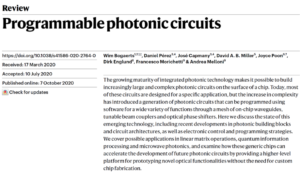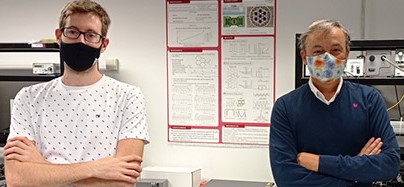The prestigious journal Nature has published an analysis on the most significant landmarks in the area of Programmable Photonic circuits, a technology that is called to revolutionize the design and performance of photonic chips. The researchers from Photonics Research Labs (PRL) of iTEAM and pioneers in the field, Prof. José Capmany and Dr. Daniel Pérez, have co-authored this review paper.
Next-generation chips will include both photonics and electronics, exhibiting not only high bandwidth and speed but also processing and computing abilities that are currently unthinkable. “Programmable Photonics marks a turning point in the world of telecommunications. It is a field with great potential and value, due to the complementarity it has with electronics. Our article includes all the progress that has been achieved heretofore around the world in this field, which is garnering increased interest,” highlights José Capmany.
Democratising photonics
As part o f this progress, a special mention must go to the generic-purpose programmable chips currently being developed by the Photonics Research Labs and its spin-off company iPronics Programmable Photonics. These circuits are capable of providing numerous functionalities by using a single structure, in an analogous way as how microprocessors work in electronics. The article also includes the most recent landmarks in the development of chips for specific purposes and highlights the research of other pioneer groups in the field, such as the University of Ghent and the Polytechnic University of Milan in Europe and MIT, the University of Stanford and the University of Toronto in America.
f this progress, a special mention must go to the generic-purpose programmable chips currently being developed by the Photonics Research Labs and its spin-off company iPronics Programmable Photonics. These circuits are capable of providing numerous functionalities by using a single structure, in an analogous way as how microprocessors work in electronics. The article also includes the most recent landmarks in the development of chips for specific purposes and highlights the research of other pioneer groups in the field, such as the University of Ghent and the Polytechnic University of Milan in Europe and MIT, the University of Stanford and the University of Toronto in America.
“From a fundamental point of view, the article describes and presents the technology of integrated photonics and the different levels required – photonic hardware, control electronics and software – to make the most of the potential of this type of systems,” ads Daniel Pérez.
“As well as for the autonomous car or quantum computing, programmable integrated photonics will also help improve automated learning systems, 5G communications or the development of neuromorphic computing, with chips that will imitate the network of neurons of our brain and their connections. All these uses require great flexibility and the processing of large amounts of data at high speeds. And this is what programmable photonics offers, and it is what the article published in Nature addresses,” highlights Daniel Pérez.

